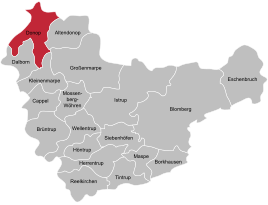Donop
|
Donop
City of Blomberg
Coordinates: 51 ° 59 ′ 16 ″ N , 8 ° 59 ′ 44 ″ E
|
|
|---|---|
| Height : | 144 m |
| Area : | 5.26 km² |
| Residents : | 597 (Dec 2007) |
| Population density : | 113 inhabitants / km² |
| Incorporation : | January 1, 1970 |
| Postal code : | 32825 |
| Area code : | 05236 |
|
Location of Donop in Blomberg
|
|
Donop is one of 19 localities in the city of Blomberg in the North Rhine-Westphalian district of Lippe in Germany .
geography
The former districts of Gehrenberg, Kirchdonop, Hagendonop and Lüdershof belong to the village. Donop is about ten kilometers northwest of the city center of Blomberg. The 52nd degree of latitude and the 9th degree of longitude meet in the Hagendonop district.
history
A document proves that Donop came to the Falkenhagen monastery church in 1246 as a gift from Count Gottschalk von Pyrmont . The document bears the signature of the bell priest Gerhard zu Dunope as a witness. The origin of the name Donop probably goes back to the "Dombach" stream, today's Donope. The Donoper Church is one of the few surviving Romanesque village churches in Lippe. The west tower and the rectangular nave were built in the early 13th century and the original baptismal font dates from around 1250. During restoration work inside the church, wall paintings from the 16th century were exposed. The church organ was built in 1689. At the beginning of the 1970s, the organ was moved from its original location in the church's choir to the tower opposite. In the course of this measure, the entire organ was completely renewed or rebuilt by the Steinmann company from Vlotho . From the old organ only the old prospectus with its carvings has been reused. The Donop Church has two bronze bells of historical value . The smaller, older bell cannot be precisely dated from the date; it is estimated to have been made in the 14th century . The larger of the two bells, the Peace Bell, dates from 1650 and was cast to commemorate the end of the Thirty Years War in 1648.
In the neighboring Altendonop had barons of Donop her castle and estate. Today neither castle nor manor buildings exist. The castle burned down in the late 1960s and was never rebuilt. The manor buildings have been demolished over the years.
Near the towns of Donop and Dalborn is the Lüdershof estate, which was built in 1699 by Levin Ernst von Donop and his wife Anna Maria von Schnarmann. The castle and manor buildings have largely been preserved.
Other villages in the area also had the name Donop in their name, such as Altendonop , Kirchdonop with a church and settlement from the 12th century and Hagendonop with a late medieval settlement in which the houses at that time, as was common in so-called Hagenhufendörfern, only stood on one side of the street.
Around 1880, the former community was dissolved and divided into the new communities Altendonop , Dalborn and Kirchdonop. The manor Altendonop also became independent and thus treated as a parish. Around 1890 the parish of Kirchdonop was renamed Donop . On January 1, 1970, Donop was incorporated into the city of Blomberg.
Residents
In Donop there are 597 inhabitants on an area of 5.26 km², which corresponds to a population density of 113 inhabitants / km². The current mayor is Lothar Vogt (as of November 25, 2014).
Economy, culture and sights
There are five full-time farms and three part-time farms in Donop. The infrastructure includes a. a Protestant church from the 13th century, an Evangelical Reformed rectory, two parish halls, a village community center , a day-care center , several small businesses, a plastics processing company, an agricultural machinery dealer, a branch of a screw wholesale company, a cemetery with a chapel, a sports field, and a riding hall Outdoor riding facility and the fire station of the volunteer fire brigade .
Web links
- Blomberg locality Donop
- Homepage of Donop
- Donop in the Westphalia Culture Atlas
Individual evidence
- ↑ Google Maps - Hagendonop - in the southeast corner of the group of trees. Retrieved September 11, 2018 (de-US).
- ^ Christian Kuhnke: Lippe Lexikon . Keyword: Donop. Boken Verlag, Detmold 2000. ISBN 3-935454-00-7
- ↑ Stephanie Reekers: The regional development of the districts and communities of Westphalia 1817-1967 . Aschendorff, Münster Westfalen 1977, ISBN 3-402-05875-8 , p. 226 .
- ↑ Martin Bünermann: The communities of the first reorganization program in North Rhine-Westphalia . Deutscher Gemeindeverlag, Cologne 1970, p. 104 .
- ↑ Mayor of the city of Blomberg
- ↑ Blomberg locality Donop



